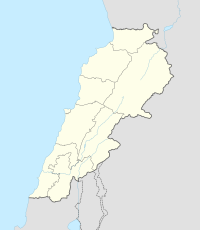Kamouh el Hermel

Kamouh el Hermel (Pyramid of Hermel)
|
|
| Alternate name | Qamouh el Hermel, Pyramid of Hermel, Hermel Pyramid |
|---|---|
| Location | Beqaa Valley, Lebanon |
| Coordinates | 34°21′50″N 36°24′56″E / 34.363889°N 36.415556°E |
| Part of | Factory |
| History | |
| Periods | Shepherd Neolithic, Ancient Greece |
| Site notes | |
| Archaeologists | Frank Skeels, Lorraine Copeland, René Dussaud |
| Condition | restored in 1931, faces somewhat damaged |
| Public access | Fenced off |
Kamouh el Hermel, Qâmou el Hermel, Qamouh el Hermel, Qâmoûaa el Hermel, Kâmoâ el Hermel, the Pyramid of Hermel or Hermel Pyramid (also known as God's Pyramid, House of El, the Funnel of Hermel or Needle of Hermel) is an ancient pyramid located 6 kilometres (3.7 mi) south of Hermel in Baalbek-Hermel Governorate, Lebanon.
The pyramid has been suggested to date to the first or second century BC due to similarities with architecture of tower tombs of the late Selucid era at Palmyra in Syria. It was considered by William McClure Thomson to possibly have been of Ancient Greek construction, however the lack of inscriptions puzzled him as he thought the ancient Greeks to be a "scribbling generation". Thomson also entertained the notion, along with Charles William Meredith van de Velde that the construction may have been Assyrian.René Dussaud later suggested that although the reliefs resembled the Ishtar Gate, the edifice was likely a monument to the hunting prowess of a member of Syrian royalty from the first century BC.
The pyramid sits on top of a hill that is clearly visible from a distance and has been fenced off to prevent damage. It is between 19.6 metres (64 ft) and 27 metres (89 ft) high and sits on a base measuring around 1.1 metres (3.6 ft) with three steps made from black basalt. On the base site two massive limestone blocks weighing between 40 tonnes (40,000 kg) and 50 tonnes (50,000 kg). The blocks are around 7 metres (23 ft) high and 9 metres (30 ft) wide and are crowned by a pyramid measuring some 4.5 metres (15 ft) high. Some sections of the monument were restored in 1931. A relief on the north side depicts two deer, possibly caught in a hunting trap. On the east side is a carved image of a boar being attacked by dogs and speared. The south side is badly damaged but shows an image considered possibly to be a bear. The relief on the west side shows two wolves attacking a bull.
...
Wikipedia

